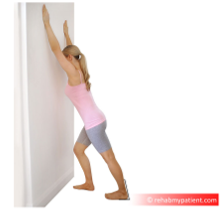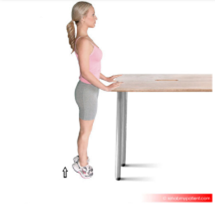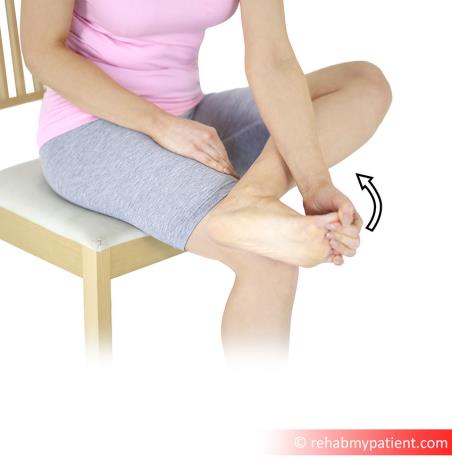Underside of the Heel Pain
Information and exercise leaflet for patients and carers
What is the Plantar Fascia?
The plantar fascia is a thick band of tissue or “fascia” on the sole of the foot. It runs from your heel to the bases of your toes and can be felt just underneath your skin. It helps to support the arch of your foot, and acts as a shock absorber, allowing the foot to take your body weight during standing activities.
What is Plantar Fascia Pain?
The condition was previously known as plantar fasciitis, but new research has shown that inflammation or “itis” isn’t always present.
Plantar fascia pain is a common condition, especially in people aged 40-60 years. It normally occurs in one foot but people can have symptoms in both.
Plantar fascia pain is now thought to occur due to gradual changes in the structure of the plantar fascia tissue over time. These changes leave the plantar fascia unable to shock absorb and tolerate weight as effectively, leading to it becoming overloaded and painful. Risk factors for developing plantar fascia pain include:
- Changes to your daily activity levels, either doing more or less
- Long periods standing on your feet, especially on a hard surfaces
- Reduced ankle movement, often due to tight calf muscles
- Weakness of your calf, ankle or foot muscles
- Inappropriate footwear
- Other contributing health factors include being overweight
Common Features
Most people experience a pain on the sole of their foot around the heel and arch. This is worse on the first few steps after rest – such as on getting out of bed or weight bearing after a period of sitting. The area is often very tender to touch.
Symptoms can ease after a few minutes once you have got going but may come on again after continued time on your feet.
What is the Treatment?
First line management and rehabilitation is effective and involves:
- Modifying your activity levels e.g. taking breaks from standing regularly, planning out walking, exercise and recovery amounts evenly over the course of the week (see below)
- Stretching exercises for the calf muscles and Plantar Fascia (see below)
- Foot and ankle strengthening exercises (see below)
- Footwear advice – alternating between different pairs of comfortable footwear where possible.
- Using a soft gel heel cup may give symptomatic relief.
- Pain relief
- Weight management advice
Some people may be referred to other health professionals such as Physiotherapists or Podiatrists.
For most people it will take at least three months of consistently applying the correct treatments to feel significant improvement and over six months in some cases.
Activity Modification
We want to find the ideal level of activity for you, this will help settle your symptoms. Too much or too little can irritate this condition. Complete rest is not advised.
“Reaction Rules” are used to help you decide what level of activity is best. On this scale “0” means no pain at all and “10” means the worst pain imaginable.
It is common to get some reaction or pain with activity, if this is at 5/10 or below (it is an acceptable level of discomfort) and settles within 24 hours – you are doing an appropriate amount and can plan to gradually increase it over time.
If the pain is above a 5/10 and/or doesn’t settle within 24 hours, you are likely doing too much and will need to reduce your activities. Once symptoms settle, gradually build up your activity keeping within the green zones (0-5/10). Remember – these activity levels aren’t just for today, you need to take into account the average of activities over the week.
Do I need an X-ray or Scan?
Plantar Fascia Pain is a clinical diagnosis – this means it can be diagnosed by discussion and/or examination by a health care professional without the need for extra tests. You may have already had imaging showing a “heel spur”, this is the formation of extra bone where the plantar fascia attaches to the heel. It is common and not thought to be the cause of pain.
Do I need an injection?
There is evidence to show that injections can help give short-term symptom relief to people with plantar fascia pain. However, injections are not considered in most cases until at least 3-6 months of first-line management has been trialled, including referral to Physiotherapy.
Options such as exercise are very effective for most people and give much longer-lasting improvements in symptoms than injections and with less risk. Injections may be considered sooner if significant pain prevents you from engaging in rehabilitation despite working with your GP to trial pain medications. The first-line management advice in this leaflet is effective when done correctly and will not only ease pain but can also address the underlying causes.
Warning Signs
If you develop new or worsening symptoms, if you are unwell with the pain, or under the age of 16 years, seek medical advice.
The following symptoms are very rare, but if you develop any of them, you should seek urgent medical attention at your local Urgent Care Centre:
- Sudden onset of Achilles pain, with a “pop” or snapping sound/sensation.
- Inability to weight-bear through the foot/ankle.
- New significant injury to the leg/foot/ankle.
- Constant night pain in the foot/ankle (that prevents rest/sleep).
- Significant swelling, colour change or temperature change in the foot/ankle or extending up the leg.
- Lumps in the foot/ankle.
- Signs of infection i.e. night sweats that are out of the ordinary, high temperature and feeling unwell.
- Unexplained weight loss.
If your symptoms fail to improve within six to eight weeks with this regime you should contact your doctor for a physiotherapy referral.
If your symptoms are improving (even slowly), continue for up to three months.
Exercises for Plantar Fascia Pain
These exercises will aim to improve foot and ankle strength and flexibility. This is often successful at easing Plantar Fascia Pain but can take some time to have an effect.
Do not work into pain but it is ok for your muscles to feel tired. If the number of repetitions or length of the hold is too long, back off slightly, but aim to build up to the stated level.
Use the reaction rules to guide your exercise intensity. If pain is stopping you engaging in rehab, you should speak to your GP about pain relief promptly.
Flare-ups may happen; if it doesn’t settle in a couple of weeks, then seek further advice

Straight knee stretch
Place the affected leg behind you, ensuring the foot is pointing directly forwards. Fully straighten your back knee and lean forwards slightly onto the front knee. Imagine pushing your back heel firmly down into the ground, do not let it lift off the floor. You should feel a stretch in the upper calf.
Hold for 30 seconds Repeat 10 times 3 times daily

Bent knee stretch
Place the affected leg in front of you, ensuring the foot is pointing directly forwards Bend the front knee leaning into the wall to feel a stretch in the lower calf of the front leg. Your weight is through the front leg on this exercise, keeping the heel flat on the ground.
Hold for 30 seconds Repeat 10 times 3 times daily

Double heel raises
- Stand in front of a stable surface for support
- Place your feet Hip width apart with a slight bend in your knees
- Take 5 seconds to slowly rise up onto your tip toes. Pause at the top 2 seconds
- Then take 5 seconds to slowly lower.
- Rise as high up as you can, keeping a slight knee bend throughout the exercise.
- Repeat as many times as you can, then rest.
- If you can do over 30 of these in one go, try to gradually take more weight through the affected leg until you are able to raise and lower whilst just stood on one leg.
Repeat 10 times 3 times daily
Build up to 30 repetitions

Plantar fascia stretch
It can be helpful to perform this exercise before standing up after rest e.g. first thing in the morning. In sitting, cross your affected leg over your other leg. Place your fingers across the base of your toes then pull your toes towards your shin until you can feel a stretch on the inside arch of your foot.
Hold for 10 seconds Repeat 10 times 3 times daily
What actions can I take to improve my health?
Evidence tells us that making healthy lifestyle choices can have a big impact on influencing problems with your muscles and bones and can play a major role in your overall health. Some of the most effective areas to address are below: (click on the links)
Maintaining a healthy weight: www.nhs.uk/live-well/healthy-weight/
Increasing levels of physical activity: www.nhs.uk/live-well/exercise/
Avoiding poor sleep patterns: www.nhs.uk/live-well/sleep-and- tiredness/how-to-get-to-sleep/
Reducing alcohol consumption: www.nhs.uk/live-well/alcohol- support/calculating-alcohol-units/
Stopping smoking: www.nhs.uk/live-well/quit-smoking/
Maintaining a healthy mind: www.nhs.uk/conditions/stress-anxiety- depression/
The good news is that you are able to influence lots of these by modifying your lifestyle. Therefore it is important that you consider addressing these areas alongside your current treatment.
You may wish to discuss any of these factors with your treating clinician who will be able to work with you and guide your long term management and support you to improve your wellbeing.
There will be information about the local services that exist within the waiting areas of the physiotherapy department and your treating clinician will be able to help signpost you to appropriate services.
The websites listed below give more information on local services available:
• Blackburn and Darwen - https://refreshbwd.com/
• East Lancashire - http://www.upandactive.co.uk/
Public Health England https://www.gov.uk/government/organisations/public-health- england
You can download a printable version of this information here.
Please note this is a PDF and does not meet accessibility needs.


